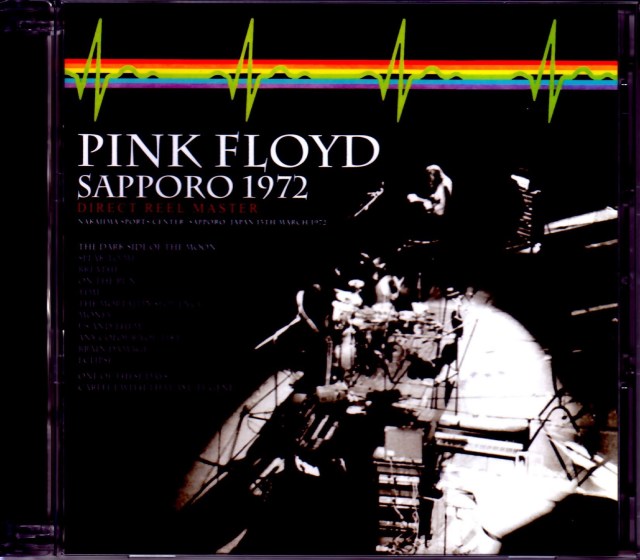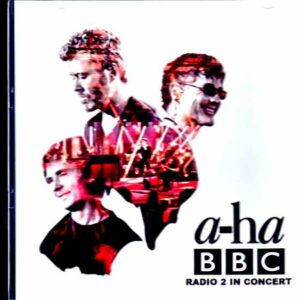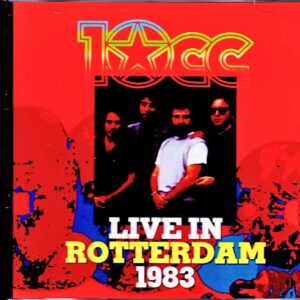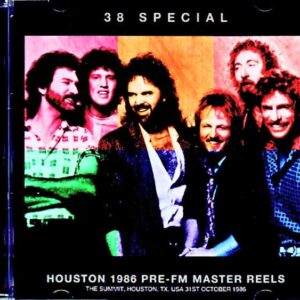Description
It’s been 45 years since Pink Floyd’s only Sapporo performance. On the night of March 13, 1972, the performance held at the Sapporo Nakajima Sports Center (now the Sapporo Nakajima Sports Center Annex) with a light snowfall was the final day of the 1972 Japan tour and the last performance in Japan by Floyd in the 1970s. No one would have thought at the time that we would have to wait a full 16 years until Floyd’s next visit to Japan in March 1988, but that’s why the position of this day as “the last performance in Japan by Floyd in the 1970s” is a particularly memorable performance day for Japanese fans here, as it forms a pair with “Hakone Aphrodite” the previous year, which was their first visit and first performance in Japan. There are three recording sources of this performance in the northern land that Floyd last visited in the 1970s, but Recorder 2, which is known for its particularly excellent recording condition, has produced various titles such as “COLD FRONT” released in 1991, Disc 2 of “MEMORIES OF THE EAST” from Sigma, and Disc 3 of “SAPPORO 1972”, and has been known as the representative source of this only Sapporo performance. The decisive factor was the release of “SAPPORO 1972: DIRECT REEL MASTER (Sigma 137)” in 2016, which was made by borrowing the actual reel tape used at the Nakajima Sports Center 45 years ago from the person who recorded Recorder 2, and it was naturally the strongest 1972 Sapporo sound source to date. However, because it was such a special and exceptional title, this title sold out soon after its release and has remained so to this day, but this weekend, this legendary title will finally be revived as a 2-CD set coupling the original Recorder 2 reel master sound source with the latest 2017 remaster!!! First of all, Disc 1 is a straight copy of the record that immediately sold out. This is great news for those who missed out on that old work, but on the other hand, some people may think, “Is it a complete copy?” But here again, if we summarize the characteristics of the Recorder 2 actual recording provided by the recorder himself, which was used in both this latest work and the old work, the reason why Disc 1 of this work is a straight copy can be seen from the importance of the recording. (1) The actual Recorder 2 reel tape recorded that day at the Sapporo Nakajima Sports Center, provided by the recorder himself, is used. The high-quality sound that can only be achieved with the original reel sound, which deeply absorbed the air of the day, was something special that instantly wiped out the previous releases that were copied from this master tape and produced with tapes of different generations. And it also included new facts that could only be confirmed with the Recorder 2 itself. (2) One of them was the first appearance scene, which included a total of three first appearance scenes that had not been recorded on the previous releases, totaling about 2 minutes. Specifically, “a”: about 30 seconds in the introduction of “Speak to Me”, “b”: about 35 seconds in the middle of “Mad Men in Their Hearts”, and “c”: about 1 minute and 5 seconds in the sound check scene after the end of “Crazy Eclipse” to the start of the performance of “Blow Wind, Call Storm”… Of these, “c” was the most important scene of the new discovery. Normally, a break of about 20 minutes is inserted here to separate the first half of the show (= a perfect reproduction of the prototype version “Madness”) from the second half, but this Sapporo performance was the only 1972 Japanese performance that “did not have” the break that should have been there, which was revealed for the first time in Recorder 2 of this uncut non-stop recording. (3) Of course, quadrophonic = 4 channel speakers were installed in the venue on the day. The recorder himself commented that “due to this effect, the sound from the back is louder when the sound goes around the venue,” and in fact, even with this reel original sound, the sound effect is often felt as a change in sound pressure. However, this effect is weaker and is hardly felt in each of the previously released boards using tapes of multiple generations. (3) In addition, most of the previously released titles derived from this reel master had a shift in position (※ slightly leftward) that occurred when they were copied. However, of course, there is no such shift in position in this reel actual thing, and the sound image is completely fixed in the center until the end. ….etc. In other words, because it contains too realistic sound quality and too important scenes, there is no room for any tinkering. In particular, the unusual show development and speed in which “Blow Wind, Call Storm” begins with an interval of just 2 minutes after the end of “Crazy Eclipse” will give you goosebumps. That’s why these have been slate-copied to Disc 1 as the original sound source of Recorder 2 in this work. On the other hand, Disc 2 is an even higher quality disc that once again focuses on the originally excellent sound quality, and for the first time, the 2017 remastered sound adjusted with the latest equipment and technology has been recorded. Specifically, a slight delay effect = surround feeling was added to that sound, and the components that became a little thin from that process were combined with the original original sound to correct it so that it would sound natural, but this has also been revived with a special sound that brings out the exquisite tone and resonance unique to Recorder 2. The sound image is slightly harder to tighten up the overall sound image, so the sharper and more expansive sound image than the original is also a big attraction. For example, at the end of the introduction “Speak to Me”, a thick sound rises, but it is much thicker than the same part of the old version (※ = Disc 1. From now on, please think of the old version as Disc 1), and you can hear that the sound has a definite weight. The closeness of Gilmore’s singing voice in “Breath of Life” has also improved in accuracy, and the vividness of the voice and the mid-range tone have become even more vivid and massive. In “Running Around”, the original excellent quality of the reel original sound has been reexamined, and each of the complex sounds that come out in this song can be grasped in more detail. In addition, this time, the sound has a slight surround feeling, and you can see that the drama of the sound caused by the quadrophonic in the venue is skillfully drawn out. In “Time,” the tom sounds heard in the intro sound tighter than on the previous version. The two-part harmony by Rick and Gilmore, which is unusually close, is now clearer, and the sharpness of the gritty sound scattered by the guitar has been improved, so the blend of the amplitude of the low range and the edgy high range should make you aware of new possibilities of the original sound. In the early “Scat in the Void,” “The Mortality Sequence,” the brightness and resolution of the monologue sound effects that spread throughout the venue have increased by about +1, and the floating feeling and drama of the reading by tape collage are revived with sharper contours. The sound of the organ that appears at the end (from around 3 minutes 10 seconds) is also easier to grasp the contours of the tone, and you should be able to hear that the depth and breadth of the sound is deeper than the previous version. This comfortable hardness of sound is also evident in the register sound and bass touch at the beginning of “Money”, and the electric piano sound that appears in the middle, and it’s nice to hear that avant-garde approach with a sound that is much more solid than the original reel sound. The cymbals and hi-hats sounding behind the guitar solo (※ This is also a super close sound with improved resolution!) have also become clearer, and you can enjoy a sound that is a cut above the old version. In “Us and Them”, the exquisite tones flow into your ears. The introduction, the movement of the two voices, and the powerful sound of the organ played behind them are full of upper feeling, and you can understand how fine and sharp Floyd’s expression was in Sapporo. The sound of “Mad Men in the Heart”, which was already good enough on the old version, is now even more powerful, and the change in tone trying to get out of the mid-range should be even more captivating. In “Blow Wind, Call Storm”, the tuning sound before the start and the surrounding voices are clearer than before, and the bass sound at the beginning of the performance is thicker, but what I want to pay attention to is the drums behind the bass. The impression that the percussion sounds were somewhat buried has faded, and the rhythmic movement can be followed with a more responsive sound than the previous version. The scene where the rhythm disappears for a moment has a surround feeling, and the floating feeling of the sound can be felt even more deeply, and the sharp sound of the guitar and organ that pops out after the monologue also feels more expressive. The tuning scene after the final song is also brighter than what we have heard before, and you should be able to recognize the renewed feeling of the sound image. And the coming “Eugene, Beware of the Axe” is a big attraction with its maximum transparency and texture. In a sense, this is the song that shows the strongest results of the remastering, and you can enjoy not only the precision of the performance sound, but also the mysterious changes in tone that float between the sounds with even greater precision. The screams and agonized screams that are unique to the final day, which were varied until the very end, also stand out with their sharpness of the sound, and you will surely be amazed by the cleaning power of the sound that maximizes the charm of the original reel sound. …In the latter half of the text, I have roughly written down the differences in the sound feel, mainly on the remastered Disc 2, but what is actually led by this latest remaster is the sound of the previously released disc recorded on Disc 1, that is, the size of the original sound of Recorder 2. The straight reproduction and leap of the only sound left by Floyd in Sapporo 45 years ago was the aim of this latest work and the goal it was aimed at, and the ultimate coupling that has come to fruition has now become a reality. For those who missed out on the old Sigma 137 version, which immediately sold out, and for those who already own it, this is a must-listen for you! Live at Nakajima Sports Center, Sapporo, Japan 13th March 1972 TRULY PERFECT SOUND (from Original Masters) Disc 1 Original (73:40) The Dark Side Of The Moon 1. Speak To Me 2. Breathe (In The Air) 3. On The Run 4. Time 5. Breathe (Reprise) 6. The Mortality Sequence 7. Money 8. Us And Them 9. Any Colour You Like 10. Brain Damage 11. Eclipse 12. One Of These Days 13. Careful With That Axe, Eugene Disc 2 Remaster (73:40) The Dark Side Of The Moon 1. Speak To Me 2. Breathe (In The Air) 3. On The Run 4. Time 5. Breathe (Reprise) 6. The Mortality Sequence 7. Money 8. Us And Them 9. Any Color You Like 10. Brain Damage 11. Eclipse 12. One Of These Days 13. Careful With That Ax, Eugene






Reviews
There are no reviews yet.